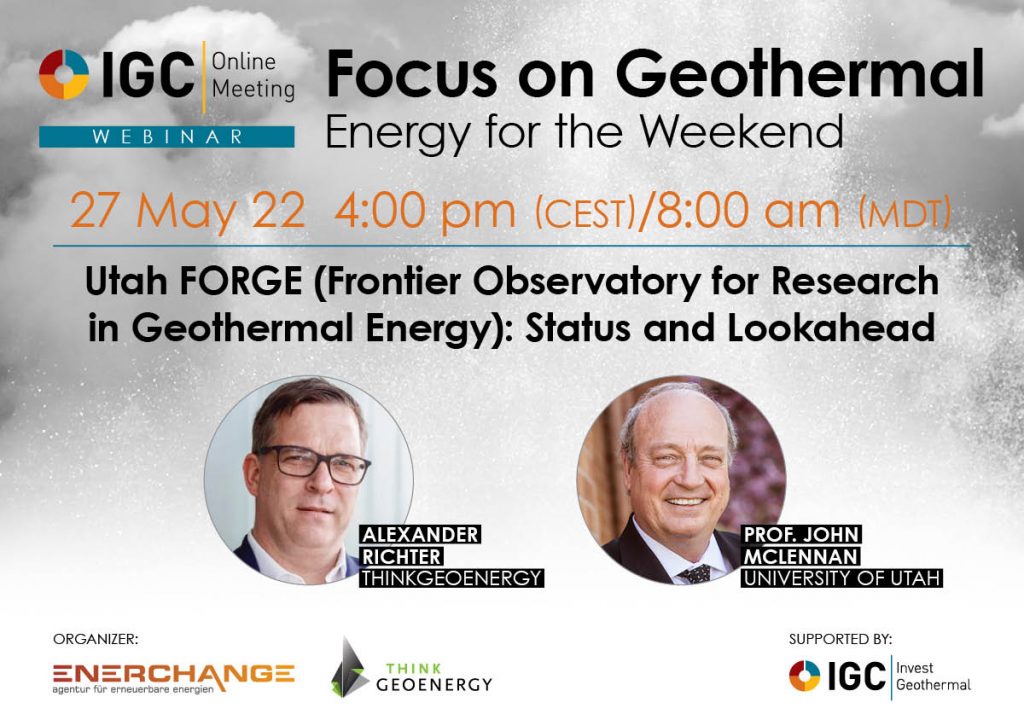Interview – Dr. John McLennan, Co-PI Utah FORGE project update
Some insights in the current status of the Utah FORGE project in this interview with Dr. John McLennan, Co Principal Investigator of the project ahead of our webinar with him on May 27, 2022.
The Utah Frontier Observatory for Research in Geothermal Energy (FORGE) is a U.S. Department of Energy-funded underground laboratory dedicated to advancing innovative technologies to unlock Earth’s limitless geothermal energy by developing Enhanced Geothermal Systems (EGS). The purpose behind EGS is to create the required hydrothermal reservoirs where none exist naturally and extract the heat from hot rocks below the surface. The laboratory site is located approximately 16 km north of the town of Milford in rural southwestern Utah and the project is managed by the Energy & Geoscience Institute at the University of Utah.
In April 2022, Utah FORGE achieved a significant milestone – the first hydraulic fractures were successfully created near the bottom of the previously drilled injection well. The fracture network is the heart of an EGS platform. Dr. John McLennan, Ph.D., of the University of Utah’s Department of Engineering and co-principal investigator of the Utah FORGE project oversaw this important achievement.
Last week the project reported on the recent success, check out the article here.
Ahead of our webinar with him on May 27, 2022, he shared some insights.
1. Why is the project this important?
Some of the main elements of the FORGE field laboratory program are:
- Confirm that Connectivity between wells can be developed,
- Subsequently, demonstrate that fracture Conductivity is adequate, and,
- With Circulation experiments establish how Conformance can be achieved among all created fractures.
An injection well was drilled in late 2020. Three hydraulic fracturing stages were recently pumped at the toe of this well. This is important because the fractures generated are “the heart” of an envisioned EGS system, facilitating long-term heat exchange with the reservoir. The fracturing operations indicated that existing isolation systems (bridge plugs) functioned well at the anticipated reservoir temperatures of 225°C.
Similarly, also from an operational perspective, slickwater was effectively pumped and all zones were broken down at acceptable surface pressures. Crosslinked CMHPG was pumped – its performance at temperature and its comparative performance to the slickwater are under review. The acquired microseismic data were extensive and all were orders of magnitude less than sensible levels. Processing of the microseismicity continues and will guide the drilling trajectory for a vertically offset production well later this year. At that point, the effectiveness of Connectivity can be judged, and mitigation technologies developed if necessary.
2. How was it accomplished?
Three frac stages were pumped near the toe of the injection well. Geophones in three offset wells, surface instrumentation, and downhole fiber optic sensors in offsets triangulated on microseismic events to provide a chronologic view of the fracture geometries. The first stage treated the lower 200 feet that had not been cased. 4,261 bbl of slickwater were pumped at up to 50 bpm. The second stage used 2,777 bbl of slickwater at rates up to 35 bpm through a 20-ft long perforated section. The final stage pumped 3,016 bbl of crosslinked CMHPG at rates up to 35 bpm, through a 20-ft perforated section farther uphole.
3. How was success determined / monitored?
Usually, in hydraulic fracturing, it is not sufficient to judge success by saying that the stages were pumped to completion – as was the case here. However, in this case, with the high temperatures, the uncertainties of treating a granitic reservoir, and previous difficulties with isolating zones, some degree of success will be claimed strictly because of successful pumping. More importantly, treating pressures were close to anticipated values, all zones broke down within treating pressure limits, and exceptional microseismic data were acquired and are currently being processed.
4. How does it fit into the project?
The ability to initiate, propagate and ideally control hydraulic fracture growth is essential for realistically evaluating the potential for commercial EGS applications. Success here is relevant for promoting technical and hybrid EGS methods that use hydraulic injection to provide a heat exchange network or to achieve more effective connections with potentially productive natural fractures.
5. What was learned?
Collaboration with many organizations and individuals facilitated this successful stimulation campaign.
From the perspective of pumping, the success of the bridge plugs was relevant as were the pressure signatures during pumping. When those excess pressures are fully analyzed and combined with exceptional microseismic data, an inference of fracture geometries will be possible. Characteristics of crosslinked fluids at temperature were demonstrated, as was the ability to pump microproppant. This will also provide significant information for history matching by the Utah FORGE modeling team (https://utahforge.com/laboratory/29589-2/). Specific tracers were injected into each stage and will be another source of data for the history matching. The flowback data (rates and temperatures) as well as shut-in data are relevant for additional evaluation of the fracture extent. Data were acquired on the friction that can be expected during injection (once a system has been created by drilling the production well).
6. What’s next for the project?
Data analysis and numerical modeling are ongoing and will continue. Late this year, or early next year, the production well will be spud and drilled with the same trajectory but immediately vertically above the injection well (separated by on the order of 300 ft). It will be drilled to intersect the inferred extent of these hydraulic fractures. As necessary, connectivity will be established or improved between the two wells and short-term circulation testing will be initiated to assess thermal viability.
Don’t miss the webinar with Dr. John McLennan on an update on the Utah FORGE project on May 27, 2022 4pm (CEST), 8am (MDT).
